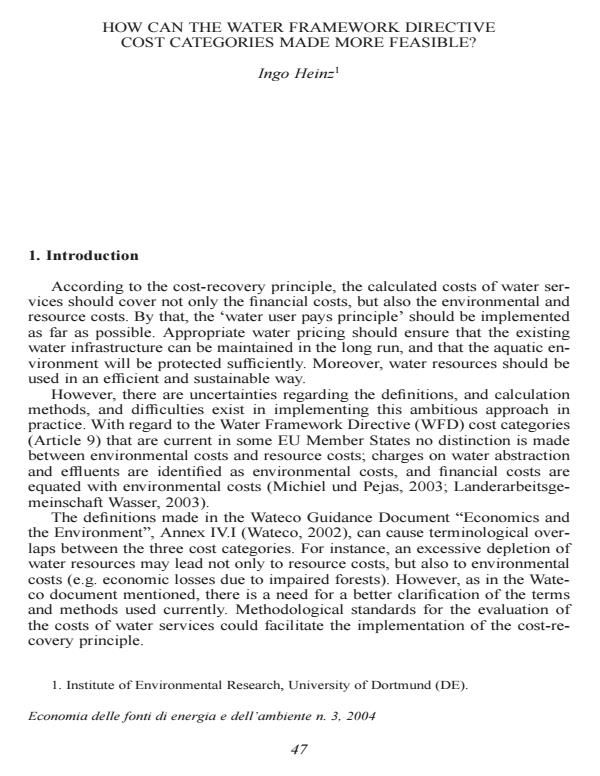How can the water framework directive cost categories made more feasible?
Journal title ECONOMIA DELLE FONTI DI ENERGIA E DELL’AMBIENTE
Author/s Ingo Heinz
Publishing Year 2006 Issue 2004/3
Language English Pages 11 P. File size 44 KB
DOI
DOI is like a bar code for intellectual property: to have more infomation
click here
Below, you can see the article first page
If you want to buy this article in PDF format, you can do it, following the instructions to buy download credits

FrancoAngeli is member of Publishers International Linking Association, Inc (PILA), a not-for-profit association which run the CrossRef service enabling links to and from online scholarly content.
<i> How can the WFD cost categories made more feasible? </i> (by Ingo Heinz) - ABSTRACT: One of the key challenges laid down in the Water Framework Directive (WFD) is to evaluate water services in such a way that the charges for such services reflect all their costs. The prices for water supply and other services have to capture the costs incurred by the provision of these services. However, in practice there are different views on this cost-recovery principle. One of them confines it to the costs of the equipment needed to ensure the provision of the services the so-called financial costs. Another approach incorporates the environmental costs, which are usually not taken sufficiently into account in cost calculations of water users. They are related to environmental damage caused, for instance, by overuse of waters or excessive water pollution. The economic evaluation of environmental damage is sometimes difficult or not possible at all. The costs of preventing and mitigating such damage are therefore often used as a proxy. A third cost definition refers to the resource costs. This category can be interpreted as those costs that are caused by a failure to use water resources optimally. A typical example is an inefficient water allocation among different water users due to a ‘wrong’ assignment of water rights. By changing such an allocation additional benefits from water use may be obtained. Another example is insufficient investment in installations to ensure water supply in the future. From a long-term perspective, the future benefits can exceed the present costs. The WFD has recognised these three cost categories. However, there are some uncertainties regarding the definitions and calculation methods. In particular, the definition of resource costs may cause confusion in distinguishing them from the environmental costs. For instance, an excessive depletion of water resources can cause both environmental damage (e.g. impaired forests) and resource costs. However, the resource costs should be understood as the additional economic value of water that is required to reach an optimal or sustainable use of water. There are several tools, such as the cost-effectiveness analysis, the cost benefit analysis or even hydro-economic models (such as developed in the Jucar river basin, Spain) which can help to determine the forgone economic benefits and the corresponding charges. With regard to the term financial costs, further clarifications also appear to be necessary, even though this type of cost calculation causes less methodological problems. There are various cost calculation methods, which can lead to considerable differences in the computed costs. For instance, discount rates in calculating the annual capital costs can differ (interest rates on capital markets versus social discount rates). The financial costs of water services can be very sensitive to changes in the value of the discount rate applied. Even a small increase in this value can make a project ‘too expensive’. A further clarification may be needed with regard to the depreciation method for calculating the annual capital costs (usually the main component of the financial costs of water services). Should they be calculated on the basis of current or future replacement values? Should they include additional investments needed in the future? In the following, the possibilities for and the limitations of the application of the ambitious WFD cost and water pricing approach will be analysed. Recommendations will also be made with regard to a clearer definition of each of the three cost categories.
Ingo Heinz, How can the water framework directive cost categories made more feasible? in "ECONOMIA DELLE FONTI DI ENERGIA E DELL’AMBIENTE" 3/2004, pp , DOI: